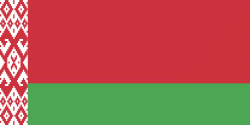Brahin (Brahin)
 |
The settlement is first mentioned in the Hypatian Codex in 1147 as the important town of the Kyiv princedom. A significant part of Brahin's population traditionally was of Jewish descent. By the end of 19th century, 2,254 of 4,311 inhabitants were Jewish. During World War II, Brahin was under German occupation from 28 August 1941 to 23 November 1943. Many Jews in the area were killed by the German forces during that time:
"On September 13, 1941, the Jews of Bragin were ordered to gather in a school for the purposes of selecting a monitor and his deputy, but when 300 Jews came at the indicated time the school they were surrounded by Germans and closed. After that, Jews were led out in groups to the edge of the village and shot."
As a result of the Chernobyl disaster, areas of the Brahin district were radioactively contaminated. 52 settlements were resettled, 9 of which are buried. From Brahin itself 1,651 families (4,892 people) were resettled.
Map - Brahin (Brahin)
Map
Country - Belarus
 |
 |
| Flag of Belarus | |
Until the 20th century, different states at various times controlled the lands of modern-day Belarus, including Kievan Rus', the Principality of Polotsk, the Grand Duchy of Lithuania, the Polish–Lithuanian Commonwealth, and the Russian Empire. In the aftermath of the Russian Revolution in 1917, different states arose competing for legitimacy amid the Civil War, ultimately ending in the rise of the Byelorussian SSR, which became a founding constituent republic of the Soviet Union in 1922. After the Polish-Soviet War, Belarus lost almost half of its territory to Poland. Much of the borders of Belarus took their modern shape in 1939, when some lands of the Second Polish Republic were reintegrated into it after the Soviet invasion of Poland, and were finalized after World War II. During World War II, military operations devastated Belarus, which lost about a quarter of its population and half of its economic resources. The republic was redeveloped in the post-war years. In 1945, the Byelorussian SSR became a founding member of the United Nations, along with the Soviet Union.
Currency / Language
| ISO | Currency | Symbol | Significant figures |
|---|---|---|---|
| BYN | Belarusian ruble | Br | 2 |
| ISO | Language |
|---|---|
| BE | Belarusian language |
| RU | Russian language |















